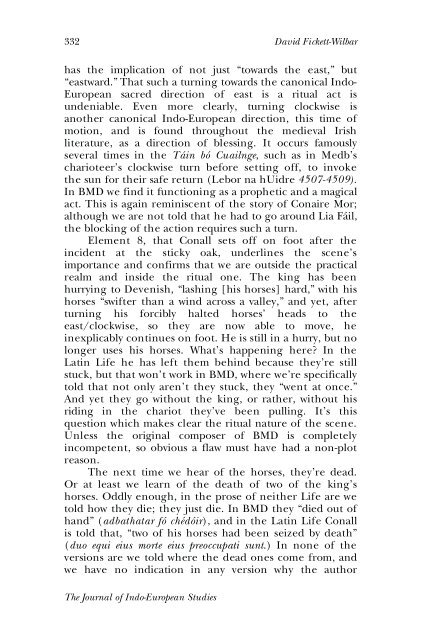Ritual Details of the Irish Horse Sacrifice in Betha ... - Clarkriley.com
Ritual Details of the Irish Horse Sacrifice in Betha ... - Clarkriley.com
Ritual Details of the Irish Horse Sacrifice in Betha ... - Clarkriley.com
Create successful ePaper yourself
Turn your PDF publications into a flip-book with our unique Google optimized e-Paper software.
332 David Fickett-Wilbar<br />
has <strong>the</strong> implication <strong>of</strong> not just “towards <strong>the</strong> east,” but<br />
“eastward.” That such a turn<strong>in</strong>g towards <strong>the</strong> canonical Indo-<br />
European sacred direction <strong>of</strong> east is a ritual act is<br />
undeniable. Even more clearly, turn<strong>in</strong>g clockwise is<br />
ano<strong>the</strong>r canonical Indo-European direction, this time <strong>of</strong><br />
motion, and is found throughout <strong>the</strong> medieval <strong>Irish</strong><br />
literature, as a direction <strong>of</strong> bless<strong>in</strong>g. It occurs famously<br />
several times <strong>in</strong> <strong>the</strong> Tá<strong>in</strong> bó Cuailnge, such as <strong>in</strong> Medb’s<br />
charioteer’s clockwise turn before sett<strong>in</strong>g <strong>of</strong>f, to <strong>in</strong>voke<br />
<strong>the</strong> sun for <strong>the</strong>ir safe return (Lebor na hUidre 4507-4509).<br />
In BMD we f<strong>in</strong>d it function<strong>in</strong>g as a prophetic and a magical<br />
act. This is aga<strong>in</strong> rem<strong>in</strong>iscent <strong>of</strong> <strong>the</strong> story <strong>of</strong> Conaire Mor;<br />
although we are not told that he had to go around Lia Fáil,<br />
<strong>the</strong> block<strong>in</strong>g <strong>of</strong> <strong>the</strong> action requires such a turn.<br />
Element 8, that Conall sets <strong>of</strong>f on foot after <strong>the</strong><br />
<strong>in</strong>cident at <strong>the</strong> sticky oak, underl<strong>in</strong>es <strong>the</strong> scene’s<br />
importance and confirms that we are outside <strong>the</strong> practical<br />
realm and <strong>in</strong>side <strong>the</strong> ritual one. The k<strong>in</strong>g has been<br />
hurry<strong>in</strong>g to Devenish, “lash<strong>in</strong>g [his horses] hard,” with his<br />
horses “swifter than a w<strong>in</strong>d across a valley,” and yet, after<br />
turn<strong>in</strong>g his forcibly halted horses’ heads to <strong>the</strong><br />
east/clockwise, so <strong>the</strong>y are now able to move, he<br />
<strong>in</strong>explicably cont<strong>in</strong>ues on foot. He is still <strong>in</strong> a hurry, but no<br />
longer uses his horses. What’s happen<strong>in</strong>g here? In <strong>the</strong><br />
Lat<strong>in</strong> Life he has left <strong>the</strong>m beh<strong>in</strong>d because <strong>the</strong>y’re still<br />
stuck, but that won’t work <strong>in</strong> BMD, where we’re specifically<br />
told that not only aren’t <strong>the</strong>y stuck, <strong>the</strong>y “went at once.”<br />
And yet <strong>the</strong>y go without <strong>the</strong> k<strong>in</strong>g, or ra<strong>the</strong>r, without his<br />
rid<strong>in</strong>g <strong>in</strong> <strong>the</strong> chariot <strong>the</strong>y’ve been pull<strong>in</strong>g. It’s this<br />
question which makes clear <strong>the</strong> ritual nature <strong>of</strong> <strong>the</strong> scene.<br />
Unless <strong>the</strong> orig<strong>in</strong>al <strong>com</strong>poser <strong>of</strong> BMD is <strong>com</strong>pletely<br />
<strong>in</strong><strong>com</strong>petent, so obvious a flaw must have had a non-plot<br />
reason.<br />
The next time we hear <strong>of</strong> <strong>the</strong> horses, <strong>the</strong>y’re dead.<br />
Or at least we learn <strong>of</strong> <strong>the</strong> death <strong>of</strong> two <strong>of</strong> <strong>the</strong> k<strong>in</strong>g’s<br />
horses. Oddly enough, <strong>in</strong> <strong>the</strong> prose <strong>of</strong> nei<strong>the</strong>r Life are we<br />
told how <strong>the</strong>y die; <strong>the</strong>y just die. In BMD <strong>the</strong>y “died out <strong>of</strong><br />
hand” (adbathatar fó chédóir), and <strong>in</strong> <strong>the</strong> Lat<strong>in</strong> Life Conall<br />
is told that, “two <strong>of</strong> his horses had been seized by death”<br />
(duo equi eius morte eius preoccupati sunt.) In none <strong>of</strong> <strong>the</strong><br />
versions are we told where <strong>the</strong> dead ones <strong>com</strong>e from, and<br />
we have no <strong>in</strong>dication <strong>in</strong> any version why <strong>the</strong> author<br />
The Journal <strong>of</strong> Indo-European Studies



